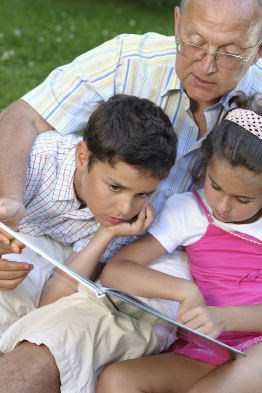Session 3
1. Session 3
1.5. Inquiry 3
Session 3: Language Development
Inquiry 3: Supporting Literacy

iStockphoto/Thinkstock
Supporting Literacy
Children begin to learn about literacy (reading and writing) as infants. This early learning is very important so that children can develop the skills needed to read and write in school.
At first, babies will bang and chew on books and will enjoy spending time with you, flipping pages and talking about pictures. They are starting to learn what books are all about. As toddlers and preschoolers continue to interact with you and with books, they gradually learn how to hold a book and turn the pages, and they learn that pictures and words have meaning and represent real objects.
They learn that the squiggles and lines on the page are letters that create words that have meaning. They learn that English books are read from left to right. They also begin to understand a story has different parts; that stories have a beginning, middle, and an end; and that stories have characters, plot, and setting.
They learn that real people write and illustrate these books. Eventually they can retell the story, act it out, or recognize some of the printed words. They can memorize the repetitive parts and ‘read’ it to you, giving them confidence to learn more. These skills are all part of learning to read. Later they can make up their own stories.
Children learn about writing by watching you. They watch you write lists, order things from catalogues, write notes to parents, and put labels on pictures and objects. They learn that printing has many useful purposes.
Children begin to write with their first scribbles. These marks will turn into pictures, and squiggles will represent letters and words. Children will tell you stories based on these pictures. When you write down what they say about their pictures, they learn that printing has meaning and purpose. They learn that ‘writing’ is just talking ‘written down.’
Strategies to Support Literacy
Follow these strategies to support children as they learn to read and write.
- Read many, many stories to children. Reading on a daily basis demonstrates that you think reading and writing activities are important. It also provides the children with ‘scripts’ for their dramatic play as they learn about other people and new experiences. They learn that print has a purpose and meaning. They learn that stories have patterns and that sometimes you might be able to predict the ending or what will happen next. They learn new words and new ways of phrasing ideas.
- Read quality preschool picture books. For very young children, look for books that have clear pictures with few words. The amount of text can increase as children get older and are able to sit longer as you are reading to them. However, preschool picture books should not be chapter books. Look for books that play with the sounds of words, have rhymes, tell a good story that is interesting to children, and present real objects or situations. The language in the text should be descriptive.
- Song books: Use picture books that have songs. Sing the song together as you read the book.
- Pointing: Look for large books, and follow the text with your finger so children can see the direction in which we read. Point out printed words around the room, on packages, and in books. When reading, you can sometimes point to the words as you read them.
- Make sure you have time to read every day. It is important for children to have fun flipping pages, looking at pictures, pointing, talking about pictures, listening to stories, and making up their own stories for the pictures they see in books.
- Read good books over again, many times. Children like to look at and talk about the same book many times with you, alone or in a small group. They learn new words and concepts every time. Choose stories, finger plays, and songs that are short and simple, and that repeat phrases and words many times.
- Read fun books. Read books with animal sounds, nonsense words, rhymes, and words that start with the same sound. Books with songs the child already knows are also fun and support the child’s understanding of print.
- Labelling and printing: Surround children with printed words on the walls in the room. Label objects in the room using lowercase letters, which is the same print they will see in books. Display names of children in the room. Write and display stories about art work. Label and display photos taken during the day. Encourage the children to write. Provide the children with paper, pencils, pens, crayons, chalk, paint, and markers to encourage children to write and draw as they play.
- Create literacy play centres. For example, set up a writing centre or “office” for preschoolers with all kinds of paper and pencils to write with, envelopes, a computer or typewriter, a phone, and phone book. Display name cards with pictures of the children in the room so they can copy each other’s names onto envelopes or letters. Make a telephone book using the children’s names and numbers.
- Use literacy props in the play centres. Turn the house area into a store, and add food boxes that have print on them, pictures of food with labels underneath, newspaper flyers from grocery stores, and grocery lists. Make sure there are pencils and sheets of paper to enable the children to write lists of their own. Include a store sign, exit and entrance signs, and a rack with newspapers, magazines, books, a cookbooks. Make available play money to buy groceries with and add anything else that you and the children can think of!
Adapted from content provided by Grant MacEwan University and Alberta Health Services.